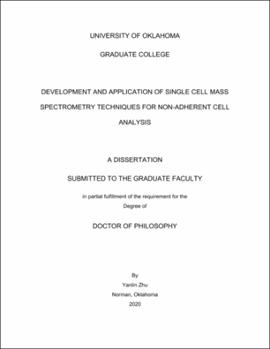| dc.contributor.advisor | Yang, Zhibo | |
| dc.contributor.author | Zhu, Yanlin | |
| dc.date.accessioned | 2020-07-22T15:33:00Z | |
| dc.date.available | 2020-07-22T15:33:00Z | |
| dc.date.issued | 2020-07 | |
| dc.identifier.uri | https://hdl.handle.net/11244/325290 | |
| dc.description.abstract | Mass spectrometry (MS) analysis of biological samples is traditionally carried out using extractions from large populations of cells, concealing the information from individual cells. In contrast, the drawbacks of traditional methods can be overcome by single cell MS (SCMS) methods, and this approach is particularly suitable to study rare types of cells that are hard to achieve or culture, including primary cells, stem cells, and patient-derived cells. Due to the super capability of MS technique, a series of SCMS methods have been rapidly developed to investigate undiscovered cellular mechanisms of a broad range of cells. My studies led to the development of two novel sampling and ionization devices for analyzing non-adherent single cells in ambient conditions: the redesigned T-probe and micropipette needle. The redesigned T-probe can be applied for real-time SCMS analysis of live single cells, without losing cell content during the analysis. In addition, this device allows for relatively long ion signal acquisition time for more molecular structure identification. The development and application of this device are described in Chapter 3. The micropipette needle is another technology for non-adherent single cell analysis. Particularly, this device can be used for reactive SCMS experiments, in which chemical reactions between cellular species and reagents can be performed prior to MS analysis, allowing for versatile experimental designs. In Chapter 4, the micropipette device was used to conduct both regular and reactive SCMS analysis of the same single cell to identify double bond locations of unsaturated lipid isomers, which are critical for the understanding of lipid biochemistry and therapeutic targets in diseases. | en_US |
| dc.language | en_US | en_US |
| dc.rights | Attribution-NonCommercial-NoDerivatives 4.0 International | * |
| dc.rights.uri | https://creativecommons.org/licenses/by-nc-nd/4.0/ | * |
| dc.subject | Single Cell Mass Spectrometry | en_US |
| dc.subject | Metabolomics | en_US |
| dc.subject | Biochemistry | en_US |
| dc.title | DEVELOPMENT AND APPLICATION OF SINGLE CELL MASS SPECTROMETRY TECHNIQUES FOR NON-ADHERENT CELL ANALYSIS | en_US |
| dc.contributor.committeeMember | Nanny, Mark A. | |
| dc.contributor.committeeMember | Shao, Yihan | |
| dc.contributor.committeeMember | Rajan, Rakhi | |
| dc.date.manuscript | 2020-07-20 | |
| dc.thesis.degree | Ph.D. | en_US |
| ou.group | College of Arts and Sciences::Department of Chemistry and Biochemistry | en_US |
| shareok.nativefileaccess | restricted | en_US |

